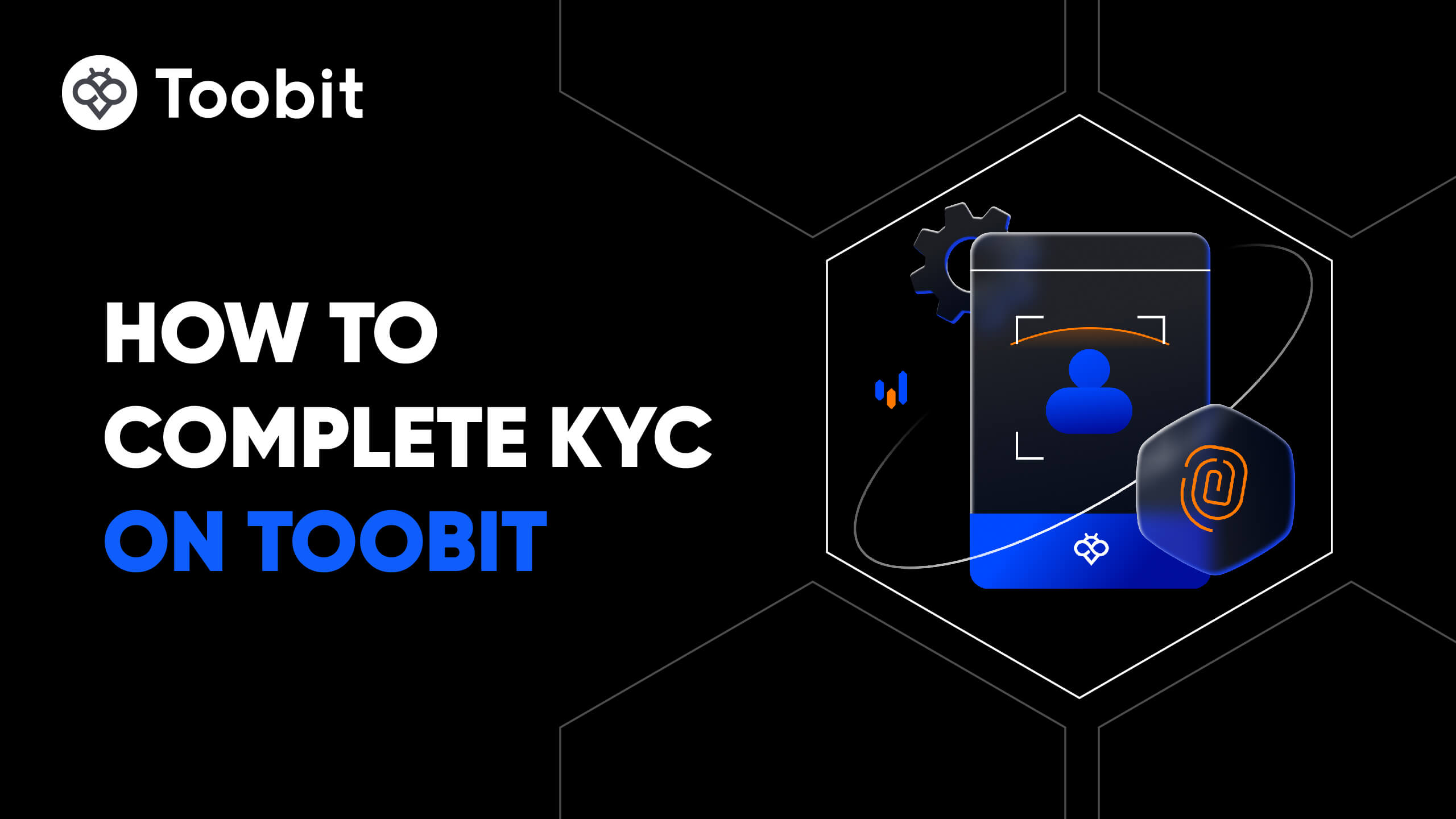Bitcoin Preis
BTCBitcoin Marktinfo
Live-Bitcoin-Preis heute in USD
Wie viel ist 1 BTC in wert?
Über Bitcoin(BTC)
Bitcoin Kursverlauf
Warum schwankt der Preis von Bitcoin ständig?
Welche Faktoren beeinflussen die Preisentwicklung von Bitcoin?
Globale Bitcoin-Preise
Wie man Bitcoin kauft
Erstelle dein kostenloses Toobit-Konto
Registrieren Sie sich bei Toobit mit Ihrer E-Mail-Adresse/Handynummer und Ihrem Wohnsitzland und erstellen Sie ein starkes Passwort zur Sicherung Ihres Kontos.
Verifizieren Sie Ihre Identität
Schließen Sie die Verifizierung Ihrer Identität ab, indem Sie Ihre persönlichen Daten und einen gültigen Lichtbildausweis einreichen.
Zahlungsmethode hinzufügen und Bitcoin (BTC) kaufen
Fügen Sie nach der Verifizierung Ihres Toobit-Kontos eine Kredit-/Debitkarte oder ein Bankkonto hinzu. Nutzen Sie mehrere Zahlungsoptionen, um Bitcoin auf Toobit zu kaufen.
Handeln Sie BTC Perpetual Futures
Nach der erfolgreichen Anmeldung bei Toobit und dem Kauf von USDT oder BTC-Token kannst du mit dem Trading von Derivaten beginnen, einschließlich BTC-Futures und Margin-Trading, um dein Einkommen zu steigern.
Treten Sie BTC Copy Trading mit Top-Tradern bei
Nachdem Sie sich bei Toobit registriert und erfolgreich USDT oder BTC Tokens gekauft haben, können Sie auch mit dem Copy Trading beginnen, indem Sie professionellen Tradern folgen.
Wo kann ich Bitcoin kaufen?
Krypto mit der Toobit-App kaufen
Registrieren Sie sich in wenigen Minuten, um Krypto per Kreditkarte oder Banküberweisung zu kaufen.
Handel auf Toobit
Überweisen Sie Ihre Kryptowährungen zu Toobit und profitieren Sie von hoher Liquidität und niedrigen Handelsgebühren.
Videoabschnitt — schnelle Verifizierung, schneller Handel

So schließen Sie die Identitätsprüfung auf Toobit ab und schützen sich vor Betrug
- 1.Melden Sie sich bei Ihrem Toobit-Konto an.
- 2.Wenn Sie neu bei Toobit sind, sehen Sie sich unser Tutorial an, wie Sie ein Konto erstellen.
- 3.Klicken Sie auf das Profilsymbol in der oberen rechten Ecke der Navigationsleiste und tippen Sie dann auf die Seite Identifikation.
Häufig gestellte Fragen zu Bitcoin (BTC)
Wer hat Bitcoin erschaffen?
Bitcoin wurde von Satoshi Nakamoto, einem pseudonymen Entwickler, der das Bitcoin-Whitepaper 2008 veröffentlichte, erschaffen. Obwohl Nakamotos wahre Identität unbekannt bleibt, starteten sie 2009 den ersten Bitcoin-Block, was die Geburt der Blockchain-Technologie markierte. Seitdem haben Entwickler wie Gavin Andresen und mehr als 750 Mitwirkende auf GitHub das Bitcoin-Netzwerk weiter verbessert und gepflegt.Wie funktioniert das Bitcoin-Mining und was ist das 'Halving'?
Bitcoin-Mining ist der Prozess der Validierung von Transaktionen und der Sicherung des Netzwerks durch Proof-of-Work. Miner konkurrieren darum, komplexe mathematische Rätsel zu lösen, und der Erste, dem dies gelingt, erstellt einen neuen Block in der Blockchain. Im Gegenzug erhalten sie eine Blockbelohnung in neu geprägtem Bitcoin. Das Halving ist ein programmiertes Ereignis, das diese Belohnung etwa alle vier Jahre halbiert. Dieser deflationäre Mechanismus ist in den Bitcoin-Code eingebaut, um das Angebot zu kontrollieren und sicherzustellen, dass die Gesamtzahl der Bitcoin niemals 21 Millionen überschreitet.Wann ist das Bitcoin-Halving?
Das letzte Bitcoin-Halving fand am 20. April 2024 statt. Ein Bitcoin-Halving tritt etwa alle vier Jahre oder alle 210.000 geminten Blöcke auf, als Teil von Satoshi Nakamotos ursprünglichem Design zur Kontrolle des Angebots. Jedes Halving-Ereignis halbiert die Blockbelohnung, verlangsamt die Erstellung neuer Bitcoin und verlängert den Belohnungszyklus für Miner. Dieser eingebaute Mechanismus begrenzt das Gesamtangebot auf 21 Millionen Münzen, was hilft, Knappheit zu bewahren und Inflation zu dämpfen.Wann ist das nächste Bitcoin-Halving?
Das Bitcoin-Halving ist ein Ereignis, das etwa alle vier Jahre oder nach 210.000 geminten Blöcken stattfindet und die Rate, mit der neue Bitcoin erstellt werden, reduziert. Das jüngste Halving fand im April 2024 statt und reduzierte die Blockbelohnung auf 3,125 BTC pro Block. Das nächste Bitcoin-Halving wird für 2028 erwartet.Wie viele Bitcoins gibt es?
Bitcoin hat ein festes maximales Angebot von 21 Millionen Münzen, das durch seinen ursprünglichen Code festgelegt wurde, um Knappheit zu gewährleisten und vor Inflation zu schützen. Neue Bitcoin gelangen durch Mining in Umlauf, ein Prozess, bei dem leistungsstarke Computer Transaktionen validieren und neue Blöcke zur Blockchain hinzufügen.Die Mining-Belohnung wird etwa alle vier Jahre halbiert, was die Rate verlangsamt, mit der neue Münzen erstellt werden. Bis jetzt wurden mehr als 19,7 Millionen Bitcoin gemint, was weniger als 2 Millionen übrig lässt, die noch produziert werden müssen. Dieses begrenzte Angebot ist einer der Hauptgründe, warum Bitcoin oft als digitales Gold bezeichnet wird.Ist Bitcoin eine gute Investition?
Bitcoin wird oft als Hochrisiko-, Hochrendite-Investition angesehen, aufgrund der BTC-Preisschwankungen und der sich entwickelnden Marktdynamik. Während es starke langfristige Renditen geliefert hat, bleibt es anfällig für starke Preisschwankungen, regulatorische Unsicherheiten und potenzielle Sicherheitsrisiken.Viele Investoren sehen Bitcoin als Absicherung gegen Inflation und als Werkzeug zur Portfolio-Diversifikation, insbesondere mit dem Aufstieg von Krypto-ETFs und wachsender institutioneller Beteiligung. Es ist jedoch möglicherweise nicht für jeden geeignet. Ob Bitcoin eine gute Investition ist, hängt letztlich von Ihrer Risikotoleranz, Ihren finanziellen Zielen und Ihrem Anlagehorizont ab.Führen Sie immer Ihre eigene Recherche durch und ziehen Sie in Betracht, einen lizenzierten Finanzberater zu konsultieren, bevor Sie in Kryptowährungen investieren.Wie viele Satoshis ergeben 1 BTC?
Ein Bitcoin (BTC) entspricht 100.000.000 Satoshis. Ein Satoshi, benannt nach Bitcoins geheimnisvollem Schöpfer Satoshi Nakamoto, ermöglicht es, Transaktionen in extrem kleinen Bruchteilen durchzuführen.Diese hohe Teilbarkeit macht Bitcoin praktisch für Mikrotransaktionen, Handel und Sparen, selbst wenn sein Wert im Laufe der Zeit weiter steigt.Wer ist Satoshi Nakamoto?
Satoshi Nakamoto ist die pseudonyme Person oder Gruppe, die für die Erstellung von Bitcoin verantwortlich ist. Sie schrieben das ursprüngliche Bitcoin-Whitepaper und entwickelten die erste Version der Bitcoin-Software. Trotz der Gründung der gesamten Kryptowährungsindustrie bleibt Satoshis wahre Identität eines der größten Geheimnisse der modernen Technologie und Finanzen.Was ist Satoshi Nakamotos Vermächtnis?
Unabhängig von ihrer Identität ist Satoshi Nakamotos Vermächtnis unbestreitbar. Sie lösten das langjährige "Double-Spend-Problem" in digitalen Währungen, ohne sich auf eine zentrale Autorität zu verlassen, und schufen die erste erfolgreiche dezentrale Kryptowährung, die die Blockchain- und Web3-Revolution auslöste. Die etwa 1,1 Millionen von Satoshi geminten Bitcoins, die nie ausgegeben wurden, stehen als stilles Denkmal für ihre Schöpfung, das sowohl immensen Reichtum als auch ein dauerhaftes Engagement für ein vertrauensloses System symbolisiert.Was ist das Bitcoin-Whitepaper und warum ist es wichtig?
Das Bitcoin-Whitepaper mit dem Titel "Bitcoin: A Peer-to-Peer Electronic Cash System" ist das grundlegende Dokument, das vom pseudonymen Satoshi Nakamoto verfasst wurde. Veröffentlicht am 31. Oktober 2008, skizzierte es den Plan für die weltweit erste erfolgreiche dezentrale Kryptowährung. Das Papier ist bedeutend, weil es eine bahnbrechende Lösung für das langjährige "Double-Spending-Problem" in digitalen Währungen vorstellte, die Notwendigkeit einer vertrauenswürdigen zentralen Autorität beseitigte und die Grundlage für die gesamte Kryptowährungs- und Blockchain-Industrie legte.Was ist das Bitcoin Rainbow Chart?
Das Bitcoin Rainbow Chart ist ein langfristiges visuelles Werkzeug, das eine logarithmische Skala verwendet, um die historischen Preistrends von Bitcoin zu veranschaulichen. Jede farbige Band repräsentiert eine andere Bewertungszone, von blau (unterbewertet) bis rot (überbewertet), und hilft Benutzern, die Marktstimmung im Laufe der Zeit schnell einzuschätzen.Obwohl es nicht für präzise BTC-Preisvorhersagen gedacht ist, bietet das Rainbow Chart eine einfache Möglichkeit, potenzielle Kauf- und Verkaufszonen basierend auf der bisherigen Leistung von Bitcoin zu identifizieren.Was ist BTC/USDT?
BTC/USDT ist ein beliebtes Handelspaar, das den Wechselkurs zwischen Bitcoin (BTC) und Tether (USDT), einem an den US-Dollar gebundenen Stablecoin, widerspiegelt. Es ermöglicht Händlern, Bitcoin mit USDT zu kaufen oder zu verkaufen und bietet eine stabile und bequeme Möglichkeit, auf den Kryptomarkt zuzugreifen, ohne in Fiat-Währung umzurechnen.BTC/USDT ist eines der am aktivsten gehandelten Paare auf Börsen wie Toobit, geschätzt für seine hohe Liquidität und relative BTC-Preisstabilität.Wie unterscheidet sich Bitcoin von traditioneller Fiat-Währung?
Traditionelle Fiat-Währungen werden von zentralen Behörden wie Zentralbanken ausgegeben und reguliert. Ihr Angebot und Wert können durch staatliche Politik und breitere wirtschaftliche Bedingungen beeinflusst werden.Bitcoin hingegen funktioniert ohne einen zentralen Vermittler. Es verlässt sich auf kryptografischen Beweis und Netzwerkkonsens, um Transaktionen zu verifizieren und die Ausgabe zu verwalten, was Transparenz, Knappheit und Unveränderlichkeit gewährleistet.Was sind die Hauptunterschiede zwischen Bitcoin und traditionellem Finanzwesen (TradFi)?
Das Bitcoin-Whitepaper stellte es als dezentrale Alternative zum traditionellen Finanzwesen vor. Wichtige Unterschiede sind: 1. Dezentralisierung vs. Zentralisierung: Bitcoin arbeitet auf einem Peer-to-Peer-Netzwerk ohne Zentralbanken oder Vermittler. 2. Erlaubnisloser Zugang: Jeder kann Bitcoin nutzen oder darauf aufbauen, ohne Genehmigung zu benötigen. 3. Transparenz: Alle Transaktionen werden öffentlich auf der Blockchain aufgezeichnet. 4. Festes Angebot: Das Gesamtangebot von Bitcoin ist auf 21 Millionen begrenzt, im Gegensatz zu Fiat-Währungen, die unbegrenzt gedruckt werden können.Was ist die Blockchain und warum ist sie für die Vertrauenswürdigkeit von Bitcoin unerlässlich?
Die Blockchain ist ein unveränderliches, zeitgestempeltes Transaktionsbuch, das die Grundlage des Vertrauensmodells von Bitcoin bildet.Struktur: Transaktionen werden in Blöcken gruppiert, und jeder neue Block ist kryptografisch mit dem vorherigen verbunden, wodurch eine sichere Datenkette entsteht.Unveränderlichkeit: Sobald ein Block hinzugefügt wurde, sind seine Aufzeichnungen nahezu unmöglich zu ändern. Dies gewährleistet Transparenz, verhindert doppelte Ausgaben und eliminiert die Notwendigkeit einer zentralen Autorität.Welche Rolle spielt das Mining im Bitcoin-System und wie gewährleistet es Sicherheit?
Mining ist der wettbewerbsorientierte Prozess, bei dem Knoten Transaktionen validieren und neue Blöcke erstellen. Es erfüllt zwei Hauptzwecke: Sicherung des Netzwerks: Miner verifizieren ausstehende Transaktionen, gruppieren sie in Blöcke und lösen ein rechnerisch intensives Rätsel, das als Proof-of-Work bekannt ist. Dieser Prozess stellt sicher, dass die Blockchain manipulationssicher und vertrauenswürdig bleibt. Ausgabe neuer Bitcoin: Der erste Miner, der das Rätsel löst, fügt den Block zur Kette hinzu und verdient neu erstellte Bitcoins (die Blockbelohnung) zusammen mit Transaktionsgebühren. Dieser wirtschaftliche Anreiz motiviert Miner, die Netzwerksicherheit aufrechtzuerhalten.Wie sichern digitale Signaturen eine Bitcoin-Transaktion und beweisen Eigentum?
Digitale Signaturen sind ein grundlegender Sicherheitsmechanismus in Bitcoin, der sicherstellt, dass nur der rechtmäßige Eigentümer von Geldern diese ausgeben kann.Mechanismus: Beim Senden von Bitcoin generiert der Benutzer eine einzigartige digitale Signatur für die Transaktion mit seinem privaten Schlüssel.Beweis: Diese Signatur verifiziert kryptografisch das Eigentum, ohne den privaten Schlüssel offenzulegen, und eliminiert die Notwendigkeit traditioneller Identitätsüberprüfung, wodurch Transaktionen sicher und nicht abstreitbar sind.Was bedeutet die Dezentralisierung von Bitcoin für Governance und Kontrolle?
Dezentralisierung bedeutet, dass keine einzelne Entität, wie eine Bank, Regierung oder ein Unternehmen, das Bitcoin-Netzwerk kontrolliert. Governance: Änderungen an den Bitcoin-Regeln erfordern Konsens von der Mehrheit der Netzwerkteilnehmer, einschließlich Miner, Knoten und Entwickler. Kontrolle: Das verteilte Hauptbuch, gesichert durch Proof-of-Work, stellt sicher, dass niemand die Geldmenge willkürlich erhöhen, Transaktionen rückgängig machen oder das Netzwerk abschalten kann. Dies untermauert den Wert von Bitcoin als zensurresistente Form von Geld.Wie adressiert das Bitcoin-Whitepaper das Konzept der Anonymität? Ist Bitcoin wirklich anonym?
Das Bitcoin-Whitepaper erklärt Anonymität durch die Verwendung von öffentlichen Schlüsseln (Bitcoin-Adressen), weist jedoch darauf hin, dass diese Anonymität Grenzen hat. Pseudonymität: Transaktionen sind öffentlich, zeigen jedoch nur Bitcoin-Adressen und keine realen Identitäten. Benutzer sind daher pseudonym und nicht vollständig anonym. Einschränkung: Wenn eine Adresse jemals mit einer Person verknüpft wird, können alle vergangenen und zukünftigen Transaktionen von dieser Adresse nachverfolgt werden. Bitcoin ist von Natur aus transparent und nicht vollständig anonym.Ist Bitcoin ein guter Wertspeicher und warum wird es 'digitales Gold' genannt?
Obwohl das Bitcoin-Whitepaper es als elektronisches Zahlungssystem präsentiert, haben Bitcoins Eigenschaften – wie Haltbarkeit, Portabilität, Teilbarkeit, Einheitlichkeit, begrenztes Angebot und breite Akzeptanz – viele dazu veranlasst, es als digitales Gold zu betrachten.Sein festes, deflationäres Angebot macht es resistent gegen Inflation, ein Schlüsselmerkmal eines Wertspeichers. Diese Perspektive ist zu einer zentralen Investitionsthese geworden, die Bitcoin als potenzielle Absicherung gegen traditionelle Finanzsysteme und als Kernanlage in modernen Portfolios positioniert.Wie wird die Sicherheit des Bitcoin-Netzwerks langfristig aufrechterhalten?
Die langfristige Sicherheit von Bitcoin wird durch mehrere Schlüsselmechanismen aufrechterhalten. 1. Proof-of-Work: Dies macht Angriffe auf das Netzwerk rechnerisch unpraktikabel. 2. Wirtschaftliche Anreize: Miner werden für ehrliche Teilnahme belohnt, was die Integrität des Netzwerks fördert. 3. Verteiltes Netzwerk: Seine dezentrale Struktur beseitigt jeden einzelnen Fehlerpunkt. 4. Kryptografie: Starke kryptografische Algorithmen sichern alle Transaktionen, und das Netzwerk bleibt sicher, solange ehrliche Knoten mehr Rechenleistung kontrollieren als potenzielle Angreifer.Kann Bitcoin zu einem globalen Zahlungssystem für alltägliche Transaktionen skalieren?
Das ursprüngliche Whitepaper erkennt an, dass Skalierung eine Herausforderung sein könnte. Es schlägt vor, dass die meisten Transaktionen außerhalb der Kette über separate Zahlungskanäle stattfinden könnten, wobei die Haupt-Blockchain verwendet wird, um diese Kanäle abzuwickeln. Dieses Konzept legte den Grundstein für Layer-2-Lösungen wie das Lightning Network, die schnelle, kostengünstige Mikrotransaktionen ermöglichen und helfen, die Skalierbarkeit für die Nutzung von Bitcoin als digitales Bargeld zu adressieren.In welcher Zeitzone wird der angezeigte BTC-Preis aktualisiert?
Der auf der Seite angezeigte BTC-Preis wird in Echtzeit unter Verwendung von UTC (Coordinated Universal Time) aktualisiert. Dies gewährleistet Konsistenz für Benutzer weltweit. Wenn Sie sich in einer anderen Zeitzone befinden, kann Ihre lokale Zeit abweichen – überprüfen Sie den Zeitstempel, bevor Sie sich auf den neuesten Bitcoin-Preis beziehen.Warum kann der Bitcoin-Preis zwischen den Börsen leicht variieren?
Da jede Börse ihr eigenes Orderbuch, ihre eigene Liquidität und ihr eigenes Handelsvolumen hat, kann der Bitcoin-Preis von einer Plattform zur anderen leicht variieren. Diese Unterschiede entstehen durch Angebot und Nachfrage auf jeder einzelnen Börse sowie durch Gebühren oder Verzögerungen, die bei bestimmten Handelspaaren anfallen können.Kann der angezeigte BTC-Preis zur Umrechnung anderer Währungen (z.B. EUR, JPY) verwendet werden?
Der angezeigte Preis ist in USD angegeben. Wenn Sie einen äquivalenten Bitcoin-Preis in einer anderen Fiat-Währung (z.B. EUR, JPY) erhalten möchten, müssen Sie den aktuellen USD-zu-Ihrer-Währung-Wechselkurs anwenden – oder ein Währungsumrechnungstool für eine genaue Umrechnung verwenden.Wie oft wird der Live-Bitcoin-Preis auf Toobit aktualisiert?
Der Live-Bitcoin-Preis-Feed wird kontinuierlich (während Trades stattfinden) aktualisiert, um die neuesten Marktaktivitäten widerzuspiegeln. Dies stellt sicher, dass Benutzer nahezu Echtzeit-Preisänderungen sehen, anstatt verzögerte oder veraltete Angebote.Beinhaltet der angezeigte BTC-Preis Handelsgebühren oder Slippage?
Nein, der angezeigte BTC-Preis repräsentiert den Marktpreis für 1 Bitcoin (BTC). Er beinhaltet keine Handelsgebühren, Netzwerkgebühren oder potenzielle Slippage. Die tatsächlichen Kosten können je nach Auftragsart, Zahlungsmethode oder aktuellen Netzwerkbedingungen variieren.Was ist der Unterschied zwischen „Letzter Preis“ und „Marktkapitalisierung“, wenn ich die Bitcoin-Preis-Seite sehe?
Der „Letzte Preis“ bezieht sich auf den zuletzt gezahlten Transaktionspreis für Bitcoin (d.h. was jemand zuletzt bezahlt hat). Die „Marktkapitalisierung“ ist der Gesamtwert aller im Umlauf befindlichen Bitcoin (aktuelles Angebot × letzter Preis) und gibt Ihnen einen Überblick über die gesamte Marktbewertung von Bitcoin.Warum ändert sich der BTC-Preis jede Sekunde?
Der BTC-Preis ändert sich ständig, weil Bitcoin rund um die Uhr an globalen Börsen gehandelt wird. Jede Kauf- und Verkaufsorder beeinflusst Angebot und Nachfrage, was den Bitcoin-Preis in Echtzeit direkt nach oben oder unten bewegt. Im Gegensatz zu Aktien gibt es keine Schlussglocke. Da Bitcoin ein festes Gesamtangebot von 21.000.000 BTC hat, wird die Preisvolatilität rein durch Marktverhalten, Liquidität, Nachrichten und makroökonomische Faktoren getrieben.Welche Faktoren haben den größten langfristigen Einfluss auf den Bitcoin-Preis?
Langfristige Bitcoin-Preistrends werden hauptsächlich durch folgende Faktoren beeinflusst:Bitcoin-Halving-ZyklenInstitutionelle AdoptionMakroökonomische Bedingungen (Inflation, Zinssätze)Regulatorische EntwicklungenNetzwerksicherheit und Hash-RateDa Bitcoin ein hart begrenztes Gesamtangebot von nur 21.000.000 BTC hat, spielt Knappheit eine große Rolle bei der Erhöhung des BTC-Preises über lange Zeiträume.Wie wird der BTC-Preis über verschiedene Börsen hinweg berechnet?
Der BTC-Preis, den Sie auf den meisten Plattformen sehen, ist ein aggregierter Durchschnitt der Preise über mehrere Börsen, gewichtet nach Handelsvolumen. Aufgrund von Liquiditätsunterschieden und regionaler Nachfrage kann der Bitcoin-Preis jedoch leicht zwischen Plattformen variieren. Unabhängig von der Börse ist das umlaufende Asset dasselbe Bitcoin mit einem maximalen Angebot von 21.000.000 BTC.Warum reagiert der Bitcoin-Preis so stark auf Nachrichtenereignisse?
Bitcoin ist sehr empfindlich gegenüber:ETF-ZulassungenRegierungenZinsentscheidungenBörsenhacks oder -zusammenbrüchenInstitutionellen InvestitionsankündigungenDa der BTC-Preis das unmittelbare Marktgefühl widerspiegelt, kann selbst eine große Schlagzeile große Preisschwankungen auslösen. Das begrenzte Angebot von 21.000.000 BTC verstärkt diese Reaktionen, da keine neuen Münzen als Reaktion auf die Nachfrage erstellt werden können.Kann der Bitcoin-Preis manipuliert werden?
Kurzfristige BTC-Preisbewegungen können beeinflusst werden durch:Große „Wal“-TradesMarktmacher-LiquiditätDerivate-LiquidationenKoordiniertes HandelsverhaltenLangfristige Manipulation wird jedoch zunehmend schwierig, da die Marktkapitalisierung von Bitcoin wächst und die globale Teilnahme zunimmt. Das begrenzte Angebot von 21.000.000 BTC schränkt auch die künstliche Inflation des Assets ein.Warum fällt der BTC-Preis oft bei hohen Hebel-Liquidationen?
Wenn Händler Hebel einsetzen, können selbst kleine Bitcoin-Preisbewegungen erzwungene Liquidationen auslösen. Während großer Liquidationsereignisse fluten massive Marktverkaufsaufträge die Börsen, was zu vorübergehenden starken Rückgängen des BTC-Preises führt. Dies beeinflusst nicht das Gesamtangebot von Bitcoin von 21.000.000 BTC, sondern nur seinen kurzfristigen Marktwert.Ist der Bitcoin-Preis im Vergleich zu seinem Gesamtangebot immer noch unterbewertet?
Viele langfristige Investoren glauben, dass Bitcoin immer noch unterbewertet ist, weil:Die globale Adoption noch früh istDie Fiat-Inflation weiter steigtDie institutionelle Exposition sich ausweitetDas Angebot auf nur 21.000.000 BTC begrenzt istAus einem auf Knappheit basierenden Bewertungsmodell könnte der BTC-Preis erheblich steigen, da die Nachfrage weiter wächst, während das Angebot fest bleibt.Was sind die Hauptunterschiede zwischen Bitcoin und traditioneller Finanzwirtschaft (TradFi)?
Das Bitcoin-Whitepaper stellte es als dezentrale Alternative zur traditionellen Finanzwirtschaft vor. Wichtige Unterschiede sind: 1. Dezentralisierung vs. Zentralisierung: Bitcoin arbeitet in einem Peer-to-Peer-Netzwerk ohne Zentralbanken oder Vermittler. 2. Erlaubnisfreier Zugang: Jeder kann Bitcoin nutzen oder darauf aufbauen, ohne Genehmigung zu benötigen. 3. Transparenz: Alle Transaktionen werden öffentlich auf der Blockchain aufgezeichnet. 4. Begrenztes Angebot: Die Gesamtmenge von Bitcoin ist auf 21 Millionen begrenzt, im Gegensatz zu Fiat-Währungen, die unbegrenzt gedruckt werden können.Was ist die Blockchain und warum ist sie für die Vertrauenswürdigkeit von Bitcoin wesentlich?
Die Blockchain ist ein unveränderliches, mit Zeitstempel versehenes Transaktionsbuch, das die Grundlage des Vertrauensmodells von Bitcoin bildet.Struktur: Transaktionen werden in Blöcken gruppiert, und jeder neue Block ist kryptografisch mit dem vorherigen verbunden, wodurch eine sichere Datenkette entsteht.Unveränderlichkeit: Sobald ein Block hinzugefügt wurde, sind seine Aufzeichnungen nahezu unmöglich zu ändern. Dies gewährleistet Transparenz, verhindert doppelte Ausgaben und eliminiert die Notwendigkeit einer zentralen Autorität.Welche Rolle spielt das Mining im Bitcoin-System und wie sorgt es für Sicherheit?
Mining ist der wettbewerbsorientierte Prozess, bei dem Knoten Transaktionen validieren und neue Blöcke erstellen. Es erfüllt zwei Hauptzwecke: Sicherung des Netzwerks: Miner überprüfen ausstehende Transaktionen, gruppieren sie in Blöcke und lösen ein rechenintensives Puzzle, das als Proof-of-Work bekannt ist. Dieser Prozess stellt sicher, dass die Blockchain manipulationssicher und vertrauenswürdig bleibt. Ausgabe neuer Bitcoins: Der erste Miner, der das Puzzle löst, fügt den Block zur Kette hinzu und verdient neu geschaffene Bitcoins (die Blockbelohnung) zusammen mit Transaktionsgebühren. Dieser wirtschaftliche Anreiz motiviert Miner, die Netzwerksicherheit aufrechtzuerhalten.Wie sichern digitale Signaturen eine Bitcoin-Transaktion und beweisen den Besitz?
Digitale Signaturen sind ein grundlegender Sicherheitsmechanismus bei Bitcoin, der sicherstellt, dass nur der rechtmäßige Besitzer von Geldern diese ausgeben kann.Mechanismus: Beim Versenden von Bitcoin erzeugt der Benutzer eine einzigartige digitale Signatur für die Transaktion mit seinem privaten Schlüssel.Nachweis: Diese Signatur verifiziert kryptografisch den Besitz, ohne den privaten Schlüssel offenzulegen, wodurch die Notwendigkeit traditioneller Identitätsüberprüfung entfällt und Transaktionen sicher und unwiderruflich sind.Was bedeutet die Dezentralisierung von Bitcoin für Governance und Kontrolle?
Dezentralisierung bedeutet, dass keine einzelne Entität, wie eine Bank, Regierung oder ein Unternehmen, das Bitcoin-Netzwerk kontrolliert. Governance: Änderungen an den Bitcoin-Regeln erfordern den Konsens der Mehrheit der Netzwerkteilnehmer, einschließlich Miner, Nodes und Entwickler. Kontrolle: Das verteilte Hauptbuch, gesichert durch Proof-of-Work, stellt sicher, dass niemand die Geldmenge willkürlich erhöhen, Transaktionen rückgängig machen oder das Netzwerk abschalten kann. Dies untermauert den Wert von Bitcoin als zensurresistente Form von Geld.Wie behandelt das Bitcoin-Whitepaper das Konzept der Anonymität? Ist Bitcoin wirklich anonym?
Das Bitcoin-Whitepaper erklärt Anonymität durch die Verwendung von öffentlichen Schlüsseln (Bitcoin-Adressen), weist jedoch darauf hin, dass diese Anonymität Grenzen hat. Pseudonymität: Transaktionen sind öffentlich, zeigen jedoch nur Bitcoin-Adressen und keine realen Identitäten. Benutzer sind daher pseudonym und nicht vollständig anonym. Einschränkung: Wenn eine Adresse jemals mit einer Person verknüpft wird, können alle vergangenen und zukünftigen Transaktionen von dieser Adresse nachverfolgt werden. Bitcoin ist von Natur aus transparent und nicht vollständig anonym.Ist Bitcoin ein guter Wertspeicher und warum wird es als 'digitales Gold' bezeichnet?
Obwohl das Bitcoin-Whitepaper es als elektronisches Zahlungssystem darstellt, haben die Eigenschaften von Bitcoin – wie Haltbarkeit, Portabilität, Teilbarkeit, Einheitlichkeit, begrenztes Angebot und breite Akzeptanz – viele dazu veranlasst, es als digitales Gold zu betrachten.Sein festes, deflationäres Angebot macht es resistent gegen Inflation, ein wesentliches Merkmal eines Wertspeichers. Diese Perspektive hat sich zu einer zentralen Investitionsthese entwickelt, die Bitcoin als potenziellen Schutz gegen traditionelle Finanzsysteme und als Kernanlage in modernen Portfolios positioniert.Wie wird die Sicherheit des Bitcoin-Netzwerks langfristig gewährleistet?
Die langfristige Sicherheit von Bitcoin wird durch mehrere Schlüsselmechanismen gewährleistet. 1. Proof-of-Work: Dies macht Angriffe auf das Netzwerk rechnerisch unpraktikabel. 2. Wirtschaftliche Anreize: Miner werden für ehrliche Teilnahme belohnt, was die Integrität des Netzwerks fördert. 3. Verteiltes Netzwerk: Seine dezentrale Struktur beseitigt jeden einzelnen Ausfallpunkt. 4. Kryptographie: Starke kryptographische Algorithmen sichern alle Transaktionen, und das Netzwerk bleibt sicher, solange ehrliche Knoten kollektiv mehr Rechenleistung kontrollieren als potenzielle Angreifer.Kann Bitcoin zu einem globalen Zahlungssystem für alltägliche Transaktionen skalieren?
Das ursprüngliche Whitepaper erkennt an, dass Skalierung eine Herausforderung sein könnte. Es wird vorgeschlagen, dass die meisten Transaktionen außerhalb der Blockchain über separate Zahlungskanäle erfolgen könnten, wobei die Haupt-Blockchain zur Abwicklung dieser Kanäle genutzt wird. Dieses Konzept legte den Grundstein für Layer-2-Lösungen wie das Lightning Network, die schnelle, kostengünstige Mikrotransaktionen ermöglichen und helfen, die Skalierbarkeit von Bitcoin als digitales Bargeld zu adressieren.


